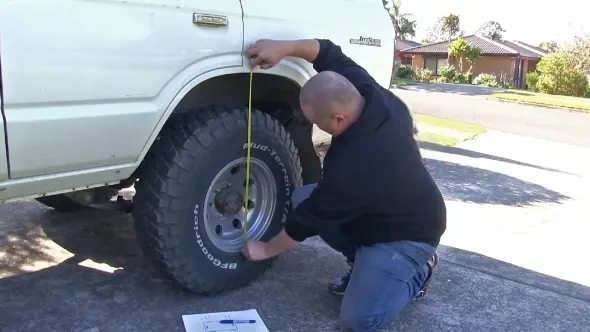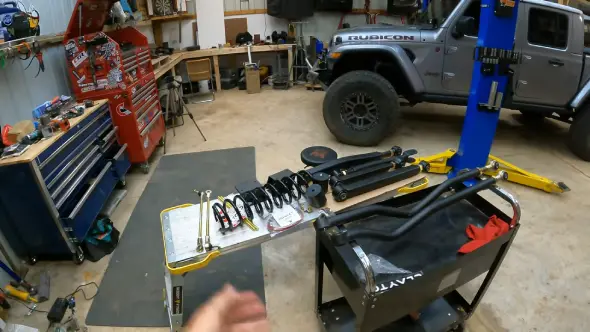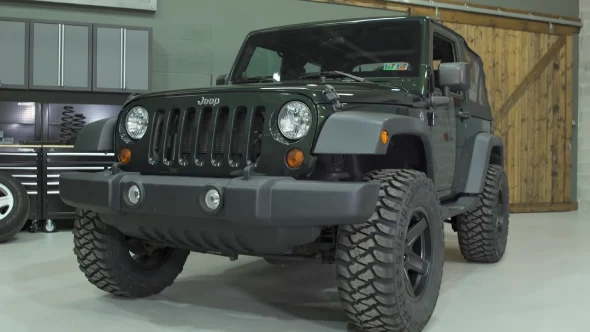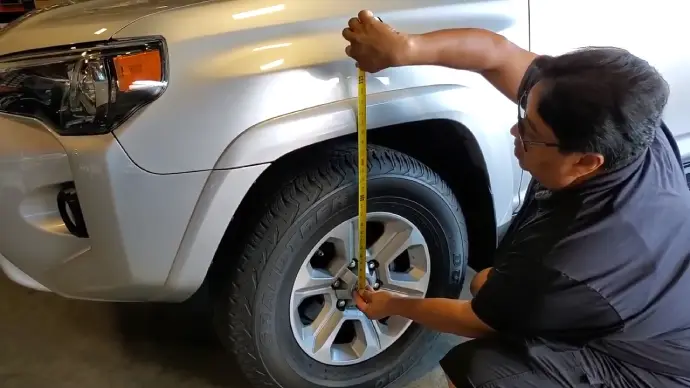Last Updated on April 15, 2023
If you have a lifted SUV, Jeep, RV truck, or other vehicle and don’t know what type of lift kit it is, fret not. There are numerous ways to identify what kind of lift kit you have. The first method would be to look through the owner’s manual or your service records.
When these documents don’t seem helpful, you could opt for measuring the height and suspension components. Similarly, look for any identifying marks on your vehicle, or research online by punching in your car model and make, along with keywords like “lift kit.”
Also, we’ll guide you in differentiating between different kinds of lift kits suited especially for Jeeps and other makes/models. By doing this, you will be able to identify what lift kit your car has.
How to Find Out What Lift Kit You Have: 8 Ways

Various methods will allow you to determine the type of lift kit installed on your RV truck, SUV, or other vehicles. Depending on the make and model of your car, some methods may be more effective than others.
Let’s explore some of the methods for identifying lift kits:
Number 01: Check the Owner’s Manual or Service Records
If you purchased your vehicle, checking the manual or service history is a great way to find out what lift kit it has. The previous owner may have noted any lift kit installation in the documents and included any related paperwork such as certificates, receipts, and instructions.
It is also possible that the owner could have kept records of any adjustments made to their vehicle during installation. If the previous owner did not leave any information about the lift kit, they likely did not install one at all.
Even if there is no mention of a lift kit in the manual or service records, it still might be possible to identify it based on other evidence.
Number 02: Measure the Height of Your Vehicle
To do this, measure the distance between the ground and the center of your vehicle’s wheel arches and subtract your vehicle’s factory ride height from this measurement.
This will give you an estimate of how much your vehicle has been lifted above its factory setting, which can provide insight into what kind of lift kit was installed.
Also, measuring your vehicle’s ride height can help you determine if additional work needs to be done to maintain or improve its performance, such as adjusting for changes in load size or improving alignment after a bumpy road trip.
Number 03: Examine The Suspension Components
Examining your suspension components is one of the effective ways to identify which lift kit is in your vehicle. Start by looking for signs of aftermarket parts or modifications: extended shock absorbers, larger coil springs, and spacers are all indicators of a lift kit installation.
Also, check for any wear and tear on the suspension components. If it appears excessive or unevenly distributed across different components, it could be due to an improperly installed lift kit.
Finally, take note of any unique design features of each component. Certain types of lifts may have more specialized parts with identifying characteristics that can help you identify the model of the lift kit.
Number 04: Look For Identifying Marks
Identifying marks on certain parts, such as shock absorbers, can also provide clues about the lift kit you have in your vehicle.
Many lifts will feature logos, labels, part numbers, or other identifying markers on their components that can help determine which model was used to install it in your car.
Also, some models may include direct instructions on adjusting their components when installing them. These instructions should include specifications about the ride height adjustment and details about the tools needed to complete installation effectively.
Number 05: Identify The Type of Lift Kit
Knowing the type and make/model number of the lift kit installed in your car is essential to confirm compatibility before modifying or repairing it.
- A body lift kit only raises the body, leaving most mechanical systems untouched.
- In contrast, a suspension lift kit includes raising the chassis and body together using longer springs and shocks along with drop brackets and spacers, among other things. This is as needed per model specifications.
- In most cases, a leveling kit consists only of taller coil springs that raise the front-end alignment relative to the rear-end alignment.
A body or suspension kit increases overall ride height when compensating for a heavy load at one end. With this information handy, you should be able to easily research compatible parts lists for whichever system you have installed to maintain it properly over time.
Number 06: Research Online
Researching online is one of the most effective ways to identify your lift kit. Many manufacturers provide detailed product information, including specifications and installation instructions.
You can easily search online forums and manufacturer websites for information related to your lift kit. Doing this will help you identify the type of lift kit and learn more about its performance and maintenance requirements.
And many automotive professionals are available online to offer advice on selecting the right lift kit for your vehicle. Based on this information, you can make an informed decision when selecting a lift kit for your car, jeep, or RV truck.
Number 07: Take Your Vehicle to a Mechanic or Off-Road Shop
Taking the vehicle to a mechanic is also an effective way to determine what lift kit you have installed. There, experienced mechanics can assess your vehicle and determine the type of lift kit installed on it.
This can provide valuable insight into the performance capabilities of your vehicle with the specific lift kit installed. It may also give you additional information about any necessary maintenance that needs to be done to keep the lift kit in optimal condition.
Number 08: Use Social Media (Optional)
Social media can be a great way to get help from experienced automotive professionals when finding out which lift kit is installed on your vehicle.
Taking detailed photos of all components related to the lift kit is recommended before posting them online or sending them via email/social media. This will ensure that people who view them can accurately identify the parts and make suggestions accordingly.
Also, using social media gives you access to a larger network of automotive experts who may be able to provide additional advice on choosing and installing a new lift kit for your vehicle.
What Are the Lift Kit Sizes?

The size of a lift kit is an essential factor when considering how much clearance and ground clearance your vehicle will have. 2, 4, 6, 8, or even 10-inch kits are available depending on the desired result, with custom larger lifts also possible.
Going too small with a lift kit can result in insufficient suspension travel and reduced performance from the suspension system. On the other hand, using too large a lift kit could result in diminished overall ride quality due to increased forces acting on the vehicle’s frame and body components.
It is recommended to consult an expert before purchasing any lift kit and ensure that all safety standards are considered before installation.
What Kind of Lift Kit Does a Jeep Have?
Jeeps typically have coil lifts, which offer more than just additional height; they also provide increased articulation and smoother rides over rough terrain due to the larger coils used in their construction.
Many off-roaders choose this style of lift kit because it offers an overall improved experience when traversing uneven ground. Coil lifts can range between 1.5 and 3.5 inches, depending on the individual’s needs and preferences.
But some people may even choose taller custom kits if they require extra clearance or suspension travel.
How do I Know What Size Lift Kit I Want On My Jeep Wrangler?

When upgrading to larger tires on a Jeep Wrangler, it is crucial to consider which size lift kit will work best for optimal performance.
Usually, when installing 33-inch tires, a 1.5-inch lift should be sufficient, while 35-inch tires require at least a 2.5-inch lift or possibly up to a 3.5-inch lift for better ground clearance and overall performance.
For 37-inch tires, a 3.5-inch lift is recommended, preferably a 4-inch lift, for optimal performance results and improved off-road capabilities.
No matter what size your tires are, excessive lifts can cause severe damage if they aren’t installed correctly with stiffer shocks and springs, strong control arms, and more muscular axles.
Also, higher lifts may require additional modifications, such as extended sway bar links or brake lines, to reduce stress on the existing parts of the suspension system.
Determine What Type of Lift Kit Is Installed On Your Vehicle
Finding out which lift kit your vehicle has is vitally important. Doing so will ensure the performance and handling capabilities are maintained. Reading service records and manuals pertaining to your vehicle, or searching online, are great ways to start the process.
Moreover, understanding the different types and sizes of lift kits available in relation to your make/model will make it easier for you to choose what works best for you. With these helpful tips, you’re now equipped with enough information to determine precisely which lift kit is on your car.
